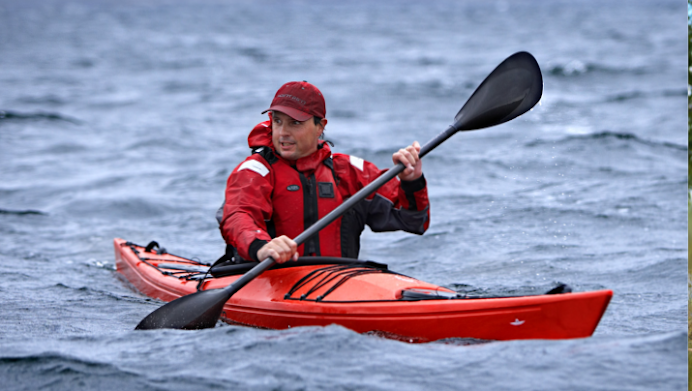David H. Johnston, who runs the always interesting blog Paddling Instructor raises an interesting issue following the latest issue of Outside Magazine who publish an eye opening analysis of the rise and subsequent collapse of whitewater kayaking largely because of extreming themselves out of mainstream.

David agrees with this and that touring does not face the same threat. But at the same time he argues that beginners should buy faster, narrower and less stable kayaks.

Hey Papa, you want to try this? Photo: Jay Carroll
I have given this issue a lot of thought but have arrived to a contrary conclusion than David. I follow him regarding windsurfing and white water who extremed themselves out of oblivion. Windsurfing started as an easy sport with large stable boards that almost anybody could learn to master.

Windsurfing started like this
It was extremely successful. Even my dad learned how and bought a board and it was easy and lots of fun.Then things got more complicated. To be cool you needed a smaller board. You needed to jump.

and went to this...
My father bailed out. After 3 years I finally quit when, with my last board, I had to start from under water and had a very hard time holding against the wind. My jumps where pathetic compared to the magazine covers. It just became to hard to master. 
Not Papa...
When comparing with windsurfing, touring paddling has seen almost the opposite development. Seakayaking (or touring) was born by extreme users paddling in narrow, unstable and fast boats in rough British seas. Wedged into impossibly small, round cockpits hard men with beards, preferably with icicles hanging out their noses, cruised the seven seas all but alone. Then something happened. The sport developed to easier to use products. Wider, more stable boats with larger cockpits that almost anybody can consider trying. With sit on tops the feeling of claustrophobia was totally eliminated.

yours truly not with Sue
This I consider the key to the lasting and long term viability of touring. That Sue cannot follow David in speed is not important. Sue would have never gotten into a narrow claustrophobic kayak in the first place. Sue doesn't like the feeling of slow drowning, trapped upside down:-) I am glad that most public images of seakayaking look inviting, calm and easy. This attracts new users to the sport. The more extreme cousins of touring have the problem of images of massive waterfalls, impossible jumps ect to fight. Given, it is fun and exciting to look at (from a safe distance).

This is not Sue but it could be
Here all you seakayaking instructors out there have a responsibility. Rolling and paddling upside down when doing public appearances is fun and attracts the folks to come watch. But they would rather be dead than put themselves in your cockpit. So show them also how easy a stable boat with a large cockpit is to use. Stand up in it (but don't fall in). Edge it, turn it, go sideways. Show them how easy it is.
Some of all those Sunday paddlers will want to progress and will learn more and exchange their stable, slow boat for something more exciting.
While many a sport take a long time to master before you can flush yourself down a waterfall, hurl yourself down a slope or balance a snow/wind/surf/skate/kite -board, touring is so easy you can head out on a full day paddling adventure your very first time.
